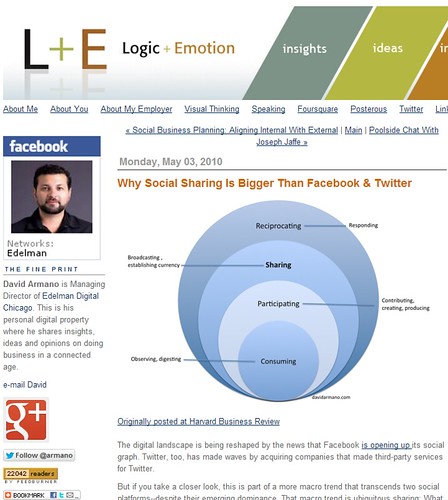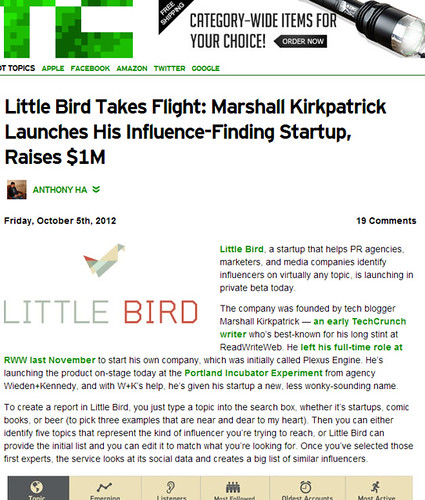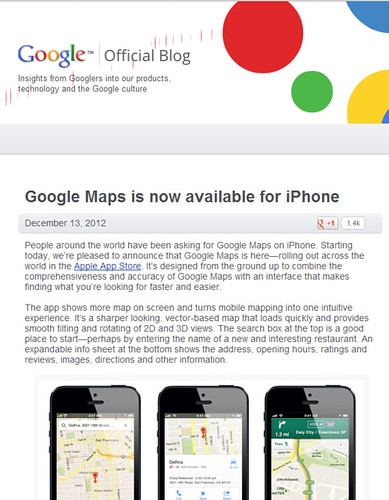 News on Social Marketing, according to Logic Emotion: So far, the most important behavioral shift of the 21st century is social sharing. Despite the emerging dominance of two social platforms – Facebook and Twitter – social sharing is a part of a more macro trend.
News on Social Marketing, according to Logic Emotion: So far, the most important behavioral shift of the 21st century is social sharing. Despite the emerging dominance of two social platforms – Facebook and Twitter – social sharing is a part of a more macro trend.
The latest platform in social sharing is called Blippy. It allows you to connect to your social system and share what you bought and how much you spent at retailers. You can log-in to these services easily from an existing social network and you can even share across multiple networks.
When it comes to the changing face of sharing in a social age, there are a few implications to consider.
Data Gathering – it is easier to sell something if we know more about an individual. Businesses will usually use socially shared data and will tap it to gain profit.
Knowledge Sharing & Collaboration – combining internal and external social sharing of large organizations could secure the future of social sharing. Newer internal platforms such as Chatter from Salesforce not only borrow from the platform designs of Facebook but they also integrate with external networks such as Twitter.
Content Distribution – by adding a “like” button or designing the content itself to be sharable, any business or individual who produces digital content can easily share it, making social sharing the ultimate form of distribution.
Social Currency – Sharing on the social web acts as a form of currency as useful information scores you points and builds equity.
Social media has led to “social sharing,” the broadcasting of our thoughts and activities. It’s not a fad. It’s a sociological phenomenon, accelerating at light speed.
Read more at Why Social Sharing Is Bigger Than Facebook & Twitter
 News on Social Marketing, according to Tech Crunch: Today, Little Bird is launched in private beta. Founded by tech blogger Marshall Kirkpatrick, Little Bird is a startup that helps PR agencies, marketers, and media companies identify influencers on virtually any topic.
News on Social Marketing, according to Tech Crunch: Today, Little Bird is launched in private beta. Founded by tech blogger Marshall Kirkpatrick, Little Bird is a startup that helps PR agencies, marketers, and media companies identify influencers on virtually any topic.
By just typing a topic into the search box, you can create a report in Little Bird. Then you can either identify five topics that represent the kind of influencer you’re trying to reach, or Little Bird can give you the initial list and you can edit it to match what you’re looking for. Then the service looks at its social data and creates a big list of similar influencers once you’ve selected those first experts.
According to Kirkpatrick, Little Bird isn’t doing any content analysis but uses the initial accounts that you provided to find the most connected people in this particular field. Subjects that are so deep and specific that there’s no core group of influencers on social media are the only exceptions.
The influencer’s data can be examined by customers through the Little Bird. You can search for an individual account and see how influential they are in a given topic; you can see the “topic insiders” who have the highest number of total followers or the insiders who are most-followed by other insiders. And to help you start conversations with those influencers, engagement tools are also available.
Although still in a pilot test, the company is expanding its social data from Twitter to include LinkedIn as well, with plans to add Google+ and academic citations soon. It also announced that it has raised $1 million in angel funding led by Mark Cuban’s Radical Investments with participation from Hubspot co-founder Dharmesh Shah, Blaine Cook, an early engineer at Twitter and Howard Lindzon’s Social Leverage Group.
Read more at Little Bird Takes Flight: Marshall Kirkpatrick Launches His Influence-Finding Startup, Raises $1M
 News on Google Marketing, according to Google: Starting today, Google Maps on iPhone is rolling out across the world in the Apple App Store. It is designed to combine the comprehensiveness and accuracy of Google Maps with an interface that makes finding what you’re looking for faster and easier.
News on Google Marketing, according to Google: Starting today, Google Maps on iPhone is rolling out across the world in the Apple App Store. It is designed to combine the comprehensiveness and accuracy of Google Maps with an interface that makes finding what you’re looking for faster and easier.
Mobile mapping will now become an intuitive experience as the app shows more map on screen. Its vector-based map is more sharper-looking that loads quickly and gives smooth tilting and rotating of 2D and 3D views. When looking for a place or restaurant, for example, you can start at the search box at the top. The address, opening hours, ratings and reviews, images, directions and other information are shown at the info sheet at the bottom.
Our constantly developing map of the world, that includes detailed information for more than 80 million businesses and points of interest, is at the heart of this app. With Street View, you can have a preview on where you want to go and see inside places with Business Photos to decide whether a table or at the bar is better. If you want to use public transportation, information for more than one million public transit stops is available and a turn-by-turn navigation, live traffic conditions to avoid the jams to get you to where you want to go.
To keep Google Maps accurate and comprehensive, tens of thousands of updates are being made daily. And to help developers use Google Maps when building their innovative apps, we are also releasing the Google Maps SDK for iOS, and a simple URL scheme.
The new Google Maps app is available for the iPhone and iPod Touch (4th gen) iOS 5.1 and higher, in more than 40 countries and 29 languages.
Read more at Google Maps is now available for iPhone
Other Social Marketing Articles of Interest
How to Educate Bosses, Colleagues and Clients about Facebook Marketing (PDF Whitepaper)
Whatever you’re looking for, Foursquare can help you find it
